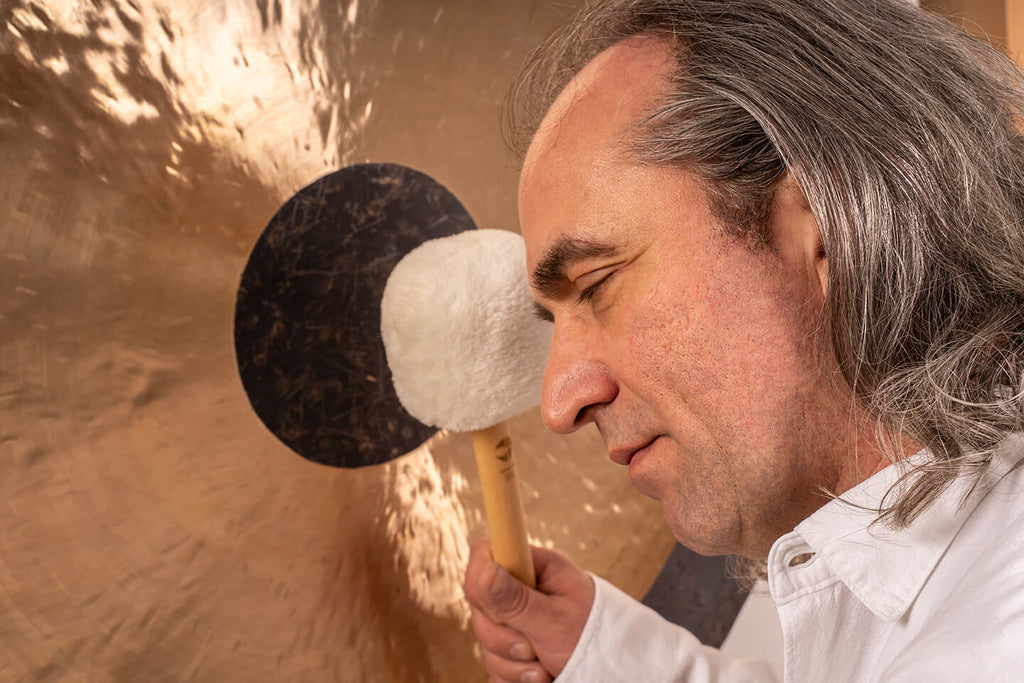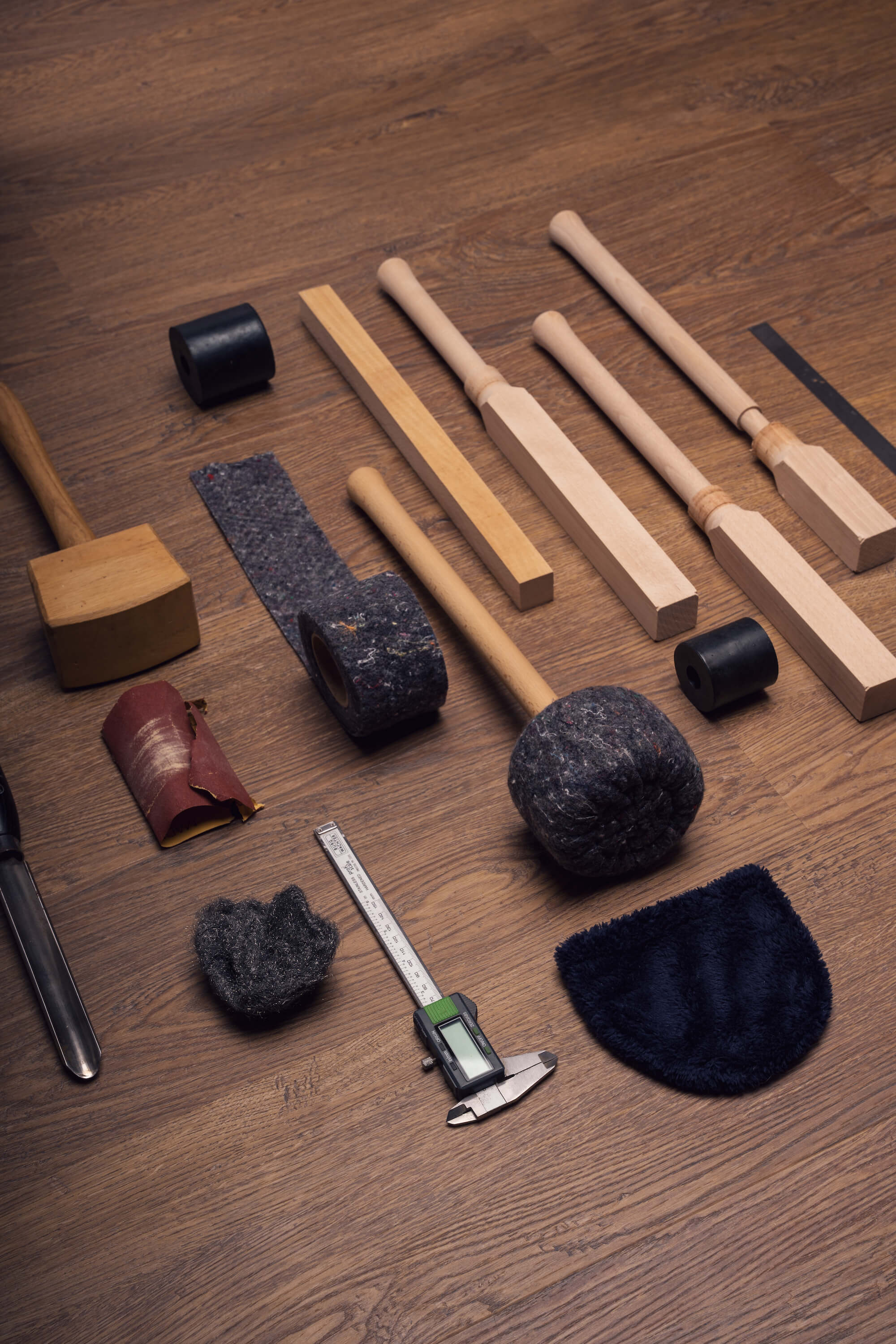The positive influence that music has on our health has been known in many cultures for hundreds of years. Even today, music therapy is often part of psychotherapeutic treatments. Sound healing, however, goes one step further. It is primarily about the sound waves that are emitted when a gong or singing bowl is played and perceived by our body. This special form of music can therefore also have a very special healing effect on us. In this article, we would like to explain to you in more detail what sound healing is all about and how it can improve your well-being.
The history of sound healing
Sound healing, also known as sound healing, goes back to a very long tradition in numerous cultures. The first references to sound healing can be found in Greek mythology: Apollo, the god of music and medicine, combined the glorious sounds of the world with mystical rituals to heal people, animals and gods in this way. According to tradition, Asclepius, the son of Apollo, also used music to heal psychological ailments. Of course, there is also much more earthly evidence that sound healing was an integral part of earlier cultures. In the writings of famous philosophers, including Plato and Aristotle, there are repeated references to how music can influence and carry our emotions. A tribe of indigenous people in the Amazon, the Icaro, hummed deep-voiced mantras during many rituals, which spread across the entire continent due to their meditative effect. And even the ancient Egyptians created something with their vocal chants that is closely linked to our current understanding of sound healing. Sound healing was therefore already an important part of everyday human life many thousands of years ago and is slowly finding its way back into society in our western regions.
What is sound healing?
The aim of sound healing is to use musical sounds to improve a patient's emotional, physical, psychological or mental state of health. However, sound healing is not a clearly defined term, as each person has their own approach to musical relaxation. Sound healing with gongs or singing bowls is primarily about perceiving the sound waves that not only penetrate our hearing, but also our muscles, organs, bones and nervous system. Even a single musician in an orchestra who plays their instrument in the wrong time can throw the entire piece of music off balance - and the same applies to our bodies. If we are plagued by everyday stress, worries or moods, the human body loses its inner harmony. This is exactly where sound healing comes in and can help us to regain our inner balance and experience a moment of peace.
Facets of sound healing
Sound healing is also well suited as a relaxation technique. In addition to classical sound healing, for which gongs and singing bowls are used, musical therapy can also take on completely different facets: When healing through sound, patients can not only listen, but also sing along, create their own pieces of music, play an instrument themselves or meditate while playing sound. Every person is a unique individual and so sound healing should also be tailored to the wishes and needs of the individual.
How does sound healing work?
In sound healing, musical sound waves in particular play a role, penetrating the body and flooding it with a feeling of calm. To symbolize this, you can take a look at water: Even a single sound can cause a lake to form waves and start moving. Sounds are transported four times faster through water than through the air - think of whale songs, for example, which sound intense and pleasant to us due to the structure of the water. The human body also consists of around 70% water. We therefore also benefit from the effect of the sound waves used in sound healing. The vibrations created by a gong or the melodic playing of singing bowl can therefore have a direct influence on our well-being.
What types of sound healing are there?
In sound healing, good is what feels good. Particularly when it comes to music, individual preferences and wishes are as varied as the people themselves. That is why there are countless variations of sound healing.
Sound healing with gongs and singing bowls
Probably the most traditional and classic form of sound healing is performed with the gong. Different types of gong and gong mallets or gong drivers can be used. The interplay of very deep, dark tones and bright, lively notes makes the gong a popular instrument for sound healing. The intensity of the sound waves emitted is also particularly high, which can amplify the effect on our body many times over. In sound healing with the gong, people benefit above all from the meditative effect created by the interplay of the different tones. The gong is considered a calming instrument that provides peace and serenity. The same applies to sound healing with singing bowls, which uses slightly more subtle tones to create a moment of relaxation.

Different methods of sound healing
Over the years, various approaches to sound healing methods have become established. You should always decide for yourself which one you can identify with and feel comfortable with:
Bonny method
In the Bonny method, sound is combined with the presentation of images. Patients have to concentrate on both influences and can thus gain access to their inner imbalance.
Dalcroze method
This method is often used with young people to improve the development of children and adolescents. It uses a combination of rhythm and expression to strengthen cognitive and motor functions.
Mantra
The classic form of meditation is the mantra. Here, the therapist does not use any instruments, but only their voice. By repeatedly chanting certain mantras, which are often expressed in the form of a hypnotic chant, the listener enters a meditative state. This is said to have several positive effects on human health - including improved sleep, lower blood pressure and stress reduction.
Neurological sound healing
This form of sound healing is based on scientific findings. The positive influence of music and the joy that is triggered by making music yourself appeals to certain areas of the brain and thus has neurological effects on the patient's health.
Nordoff-Robins method
This is also primarily a scientific approach. This method is mainly used for patients with developmental disorders and mental illnesses. The hypothesis is that every person has their own sense of music. The Nordoff-Robins method aims to promote this sense so that people with autism, depression, learning difficulties or other mental disorders can express their feelings. This form of sound healing is also frequently used for severe trauma.
Stem frequency entrainment
This form of sound healing relates to our innermost being. It is assumed that every soul has its own frequency range, which should be addressed by certain sounds. Stress in everyday life and the noise of the outside world are said to have a negative effect on this frequency. This is counteracted with the help of root frequency entrainment.
singing bowls-therapy
singing bowls were used centuries ago to achieve a meditative state. Gentle sounds are said to calm the soul and help to release inner fears and stress. The combination of sound and meditation plays a particularly important role in this form of sound healing. Singing bowl meditations have a particular effect on your well-being.
Tuning fork therapy
The sound waves, which play such an important role in sound healing, are transmitted directly to the body during tuning fork therapy. The therapist places the tuning fork on certain parts of the body and produces gentle sounds that are transmitted directly to the body. In this way, the sound waves of the music can be targeted at specific positions in order to have a positive effect on the body - for example, for tension, headaches or everyday stress.
Vibroacoustic therapy
In this form of sound healing, the therapist also introduces the sounds directly to the patient. The patient lies down on a specially prepared couch with loudspeakers positioned around them. The sounds are intended to penetrate the body in a targeted manner in order to have a positive effect on well-being.
What can sound healing do?
The possible effects of sound healing on our bodies are manifold. Studies have shown that listening to music can help to alleviate pain and reduce anxiety. However, which music is best suited for this purpose always depends on the individual - it is therefore impossible to say which instruments will have the desired effect. Every sound has its own Frequency and the human body reacts very differently to them. For this reason, sound therapy should always be tried out to see which sounds achieve the desired effect. Sound healing is therefore a very individual approach that always focuses on the person. Sound therapy can help with many problems:- Stress in everyday life
- Tension
- Headache
- Pain in the limbs
- Depression
- Traumas
- Developmental disorders
- Learning disabilities
- States of anxiety
- Physical pain
- Memory problems
- Sleep problems
- Weak immune system
Sound healing can also help with many other illnesses, as it contributes to an improved sense of well-being and thus also strengthens the body's healing powers.

Which instruments are suitable for sound healing?
There really are no limits to your imagination here, as almost any instrument can be used for sound healing, as long as the vibrations suit the person in question. Nevertheless, over the centuries some instruments have emerged with which sound healing shows particularly effective results. But be careful: professional sound healing requires many years of training. Only experienced therapists should use the effectiveness of sounds to give their patients peace and well-being. These instruments are considered to be particularly effective in sound healing:- Gong
- singing bowl
- Indian and panpipes
- Tuning fork
- Wind chimes / Glockenspiel
- Didgeridoo
- Dulcimer
- Kalimba
- Harps
- Shruti Boxes / Harmonium
- Voice / Singing






Leave a comment
This site is protected by reCAPTCHA and the Google Privacy Policy and Terms of Service apply.